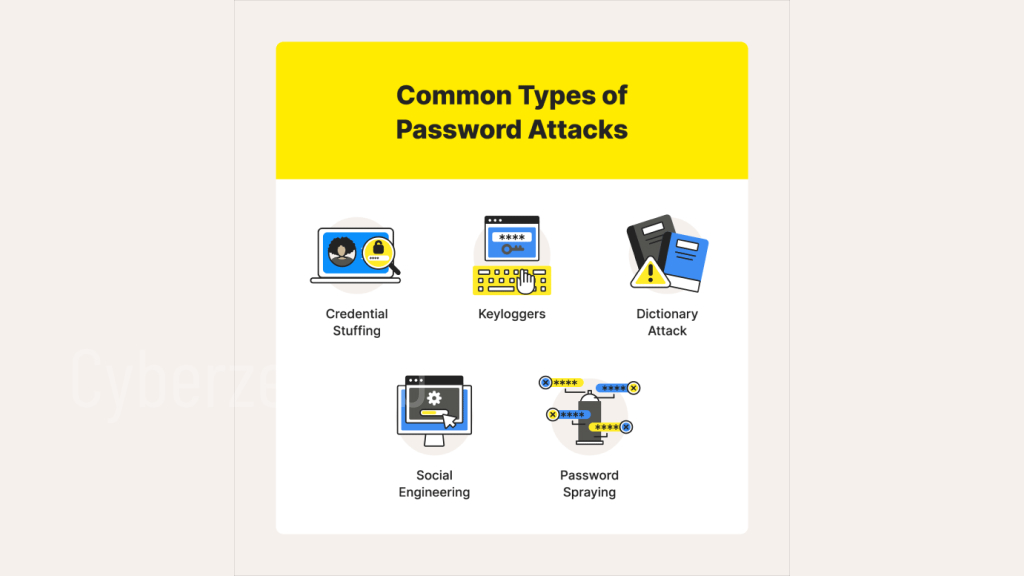Welcome to our article on the various types of password attacks that pose a threat to your online security. In today’s digital landscape, ensuring the protection of your passwords is more crucial than ever. Cybercriminals are constantly evolving their tactics, employing ingenious methods to gain unauthorized access to your accounts. That’s why it’s essential to stay informed and learn how to safeguard your passwords effectively.
In this article, we will delve into the five most prevalent types of password attacks that you should be aware of. By understanding these attacks and implementing the recommended measures, you can significantly enhance your online security posture and protect your valuable information.

Table of Contents
TogglePhishing Attacks
Phishing attacks are one of the most common and deceptive methods used by cybercriminals to steal sensitive information, including passwords. These attacks involve tricking users into disclosing their login credentials through deceptive techniques and false pretenses.
Attackers often masquerade as trusted entities, such as banks, social media platforms, or online retailers, making it difficult for users to identify the malicious intent behind their messages. They employ various techniques to exploit human psychology and manipulate users into divulging their passwords.
- Spoofed Websites: Attackers create websites that closely resemble legitimate websites to trick users into entering their login credentials. These fake websites typically have URLs that are slightly different from the genuine ones, making it challenging to detect the deception.
- Phishing Emails: Attackers send emails pretending to be from reputable organizations, enticing users to click on malicious links or download attachments. These emails often contain urgent or enticing messages that instigate immediate action.
- Social Engineering: Attackers use psychological manipulation techniques, such as creating a sense of urgency or exploiting emotions, to convince users to disclose their passwords. They may impersonate authority figures or present plausible scenarios to gain the victim’s trust.
Identifying phishing attacks requires vigilance and suspicion. Here are some tips to help users avoid falling victim to these deceptive schemes:
- Look for suspicious or misspelled URLs in emails and websites.
- Verify the authenticity of emails and messages by contacting the organization directly through official channels.
- Avoid clicking on links or downloading attachments from unknown or suspicious sources.
- Be cautious of emails or messages that create a sense of urgency or demand immediate action.
- Regularly update and use reputable antivirus software and security measures.
By staying informed and practicing caution, users can protect themselves against phishing attacks and safeguard their passwords and sensitive information.
| Phishing Attack Techniques | Examples |
|---|---|
| Spoofed Websites | Creating a fake banking website identical to the legitimate one to steal user credentials. |
| Phishing Emails | Sending an email claiming to be from a popular social media platform, requesting users to verify their account details by clicking on a link. |
| Social Engineering | Pretending to be a tech support representative and asking users to provide their passwords to resolve a fake issue. |
Credential Stuffing Attacks
Credential stuffing attacks are a type of cyber attack where attackers use leaked login credentials from one website to gain unauthorized access to user accounts on other websites. Unlike phishing attacks that rely on tricking users into revealing their passwords, credential stuffing attacks exploit the reuse of passwords across different platforms.
The process of carrying out a credential stuffing attack involves using automated scripts or bots that systematically input stolen usernames and passwords into login forms on various websites until a successful match is found. This method takes advantage of the fact that many individuals use the same password for multiple online accounts. Once a match is found, the attacker can access the compromised user account to carry out further malicious activities.
To protect yourself against credential stuffing attacks, it is crucial to follow good password hygiene practices. The first step is to ensure that you have unique passwords for each of your online accounts. This prevents attackers from gaining access to multiple accounts even if one set of credentials is compromised.
Furthermore, consider using a password manager to generate strong and complex passwords that are difficult for attackers to crack. A password manager also helps you remember and securely store your passwords, reducing the temptation to reuse them.
Enabling multi-factor authentication (MFA) adds an extra layer of security to your accounts. With MFA, even if an attacker obtains your username and password, they would still need an additional authentication factor, such as a unique code sent to your mobile device, to gain access to your account.
By implementing these precautions, you can significantly reduce the risk of falling victim to credential stuffing attacks and safeguard your personal information across various online platforms.
Brute Force and Dictionary Attacks
In the realm of password attacks, two common techniques used by hackers are brute force attacks and dictionary attacks. While they have similar end goals – cracking passwords to gain unauthorized access – their methods differ significantly.
Brute Force Attacks
Brute force attacks involve systematically trying every possible password combination until the correct one is found. This method relies on the attacker’s ability to guess the password by testing all possible combinations of characters. It can be a time-consuming process, especially for longer and more complex passwords.
Attackers employ automated software or scripts that iterate through different character combinations, starting with simple ones and gradually increasing complexity. This approach exploits the vulnerabilities associated with weak or easily guessable passwords.
Dictionary Attacks
On the other hand, dictionary attacks utilize pre-existing wordlists to crack passwords. These wordlists contain commonly used passwords, well-known phrases, and combinations derived from previous data breaches. By comparing the passwords in the wordlist with the target account’s password, attackers can identify a match and gain unauthorized access.
Dictionary attacks are often more effective than brute force attacks since they rely on the widespread usage of weak and easily guessable passwords. Additionally, attackers can augment their wordlists with personal information about the target, such as their name or birthdate, to increase the chances of a successful attack.
Preventing Brute Force and Dictionary Attacks
To protect yourself from brute force and dictionary attacks, it is crucial to create strong and unique passwords. Consider the following tips:
- Use a combination of uppercase and lowercase letters, numbers, and special characters in your passwords.
- Avoid using common words, phrases, or personal information that can be easily guessed.
- Ensure your passwords are at least 12 characters long.
- Use a password manager to generate and securely store complex passwords.
In addition to strong passwords, implementing additional security measures can further enhance your defense against these attacks. Enabling multi-factor authentication adds an extra layer of protection by requiring a second form of verification, such as a fingerprint or a one-time code.
Password Spraying Attacks
Password spraying attacks are a form of cyber attack that target weak passwords and vulnerable login systems. Unlike traditional brute force attacks that systematically try every possible password combination, password spraying attacks take advantage of commonly used passwords or weak password policies to gain unauthorized access to accounts.
Attackers employ various techniques to execute password spraying attacks. They may start by identifying commonly used passwords, such as ‘password’ or ‘123456’, and target multiple user accounts across different platforms. Alternatively, they may exploit weak password policies that allow users to choose easily guessable passwords, like dictionary words or simple number sequences.
To protect against password spraying attacks, it is crucial to follow best practices for password security. Use complex passwords that include a combination of upper and lowercase letters, numbers, and special characters. Avoid using easily guessable patterns, such as sequential numbers or common phrases. Additionally, enable multi-factor authentication whenever possible, which adds an extra layer of security by requiring users to provide additional verification, such as a code sent to their mobile device.
By implementing these preventive measures, users can significantly reduce the risk of falling victim to password spraying attacks and enhance the security of their online accounts.
Conclusion
In conclusion, password security is of utmost importance in protecting our online accounts from various types of password attacks. Throughout this article, we have discussed five common types of password attacks: phishing attacks, credential stuffing attacks, brute force and dictionary attacks, and password spraying attacks.
We have learned that phishing attacks attempt to deceive users into revealing their passwords through deceptive tactics, while credential stuffing attacks exploit leaked login credentials. Brute force and dictionary attacks rely on systematic password cracking techniques, and password spraying attacks prey on weak passwords and login systems.
To safeguard against these threats, it is crucial to implement proactive measures. Firstly, always be vigilant and wary of suspicious emails or messages that may be phishing attempts. Secondly, maintain unique passwords for each online account to prevent credential stuffing attacks. Thirdly, create strong and complex passwords, and consider implementing additional security measures like two-factor authentication to protect against brute force and dictionary attacks. Lastly, stay one step ahead by using complex, unique passwords and enabling multi-factor authentication to defend against password spraying attacks.
By implementing these strategies and tips, we can significantly reduce the risk of falling victim to password attacks and ensure the security of our online accounts. Remember, proactive measures and password security are the key to keeping our digital lives safe.
FAQ
What are the different types of password attacks?
The five main types of password attacks are brute force attacks, dictionary attacks, phishing attacks, rainbow table attacks, and password spraying attacks.
What is a phishing attack?
A phishing attack is a type of cyber attack where attackers try to deceive users into revealing their passwords by posing as a legitimate entity, such as a bank or an email provider. They often use emails, fake websites, or phone calls to trick users into providing their login credentials.
How can I identify and avoid falling victim to phishing attacks?
To identify and avoid phishing attacks, you should scrutinize emails and messages for spelling or grammatical errors, check the URL of websites to ensure they are secure, avoid clicking on suspicious links or downloading attachments from unknown sources, and regularly update your devices with the latest security patches.
What is a credential stuffing attack?
A credential stuffing attack is when attackers use stolen username and password combinations to gain unauthorized access to multiple accounts. They automate the process of trying these combinations on various websites and online platforms, taking advantage of users who reuse passwords across multiple accounts.
How can I protect myself against credential stuffing attacks?
To protect yourself against credential stuffing attacks, you should use unique passwords for each online account, enable two-factor authentication whenever possible, regularly monitor your accounts for any suspicious activities, and use a password manager to securely store and generate strong passwords.
What are brute force and dictionary attacks?
Brute force attacks and dictionary attacks are methods used by hackers to crack passwords. Brute force attacks involve systematically trying every possible password combination until the correct one is found, while dictionary attacks use pre-existing wordlists to guess passwords based on commonly used terms or common variations.
How can I prevent brute force and dictionary attacks?
To prevent brute force and dictionary attacks, it is important to create strong and unique passwords that include a combination of uppercase and lowercase letters, numbers, and special characters. Additionally, implementing measures such as account lockouts, CAPTCHAs, and rate limiting can help protect against these types of attacks.
What is a password spraying attack?
A password spraying attack is a technique where hackers target multiple accounts using a few commonly used passwords or easily guessable passwords. These attacks exploit weak password policies or the tendency of users to use easily identifiable passwords, such as “password” or “123456.”
How can I defend against password spraying attacks?
To defend against password spraying attacks, you should use complex and unique passwords for each account, avoid using commonly used passwords or easily guessable patterns, enable multi-factor authentication whenever possible, and regularly update your passwords to ensure maximum security.















